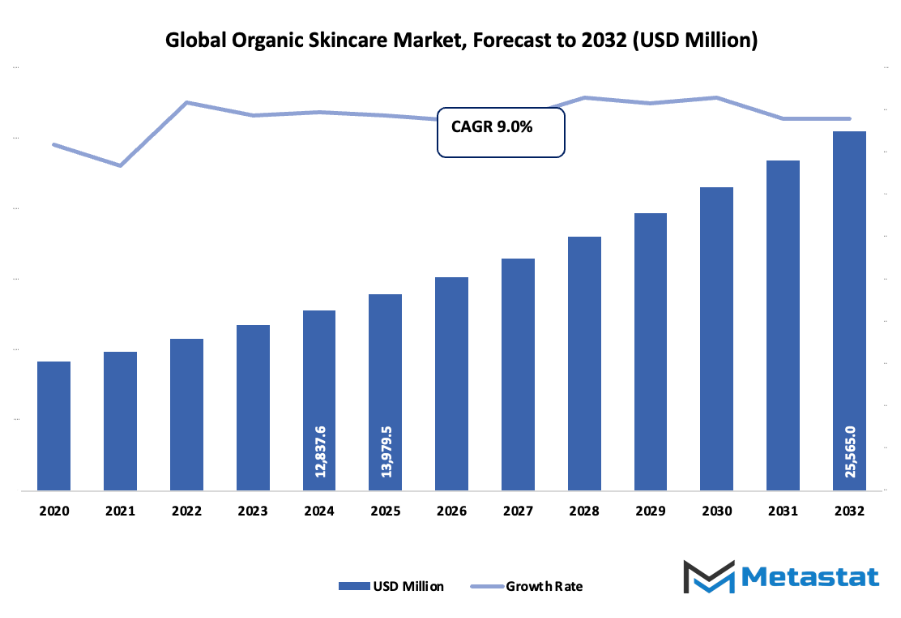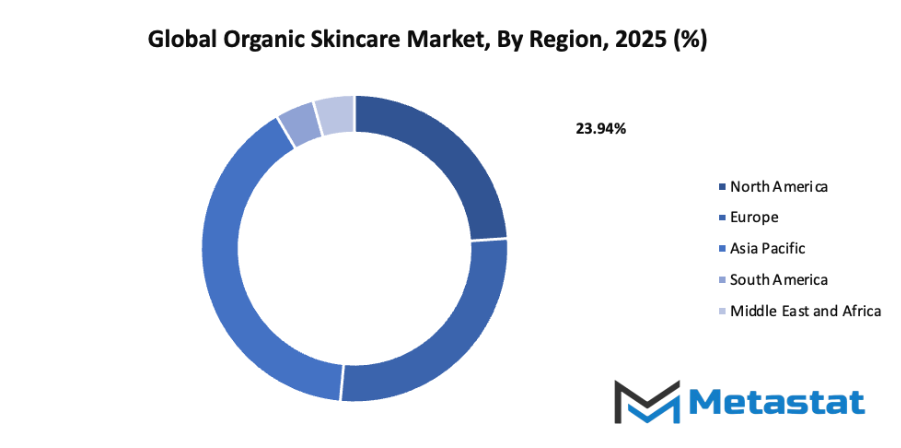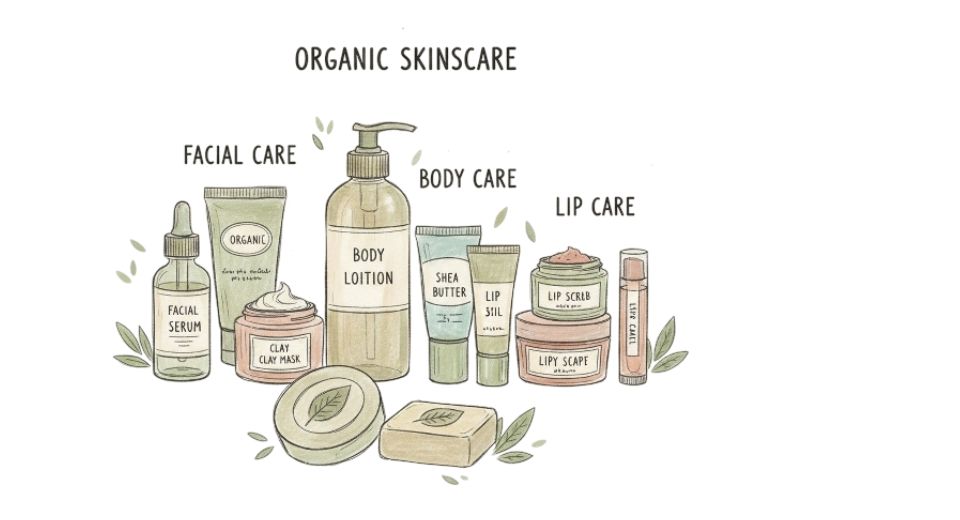Global Organic Skincare Market - Comprehensive Data-Driven Market Analysis & Strategic Outlook
The global organic skincare market has evolved from a tiny niche within health food stores to one to be challenged within the beauty industry. It originates in the late twentieth century when consumers first started questioning the long lists of chemicals within everyday products. The early consumers who bought in were attracted to synthetic ingredients, animal testing, and environmental harm. What started as a cottage and herbalist phenomenon eventually found its way onto mainstream shelves. The visionaries of the original Organic Skincare movement paved the way for an industry that would go on to reverse-engineer the definition of beauty and health.
- Global organic skincare market valued at approximately USD 13979.5 million in 2025, growing at a CAGR of around 9.0% through 2032, with potential to exceed USD 25565 million.
- Facial Care account for nearly 79.3% market share, driving innovation and expanding applications through intense research.
- Key trends driving growth: Increasing consumer awareness about harmful chemicals in conventional skincare products, Rising demand for natural and eco-friendly personal care products
- Opportunities include: Growing trend of clean beauty and sustainable, certified organic product lines in global markets
- Key insight: The market is set to grow exponentially in value over the next decade, highlighting significant growth opportunities.
- It was the shift from niche to widespread acceptance that proceeded with greater speed in the early 2000s.

As the internet ushered in discussions regarding ingredient transparency, individuals grew more consciously aware of what they were applying on their skin. Independent brands that offered cleaner, plant-based products gained devoted followings. Certification groups began to standardize the term "organic" so that it was less confusing and there was more trust between brands and consumers increased. Luxury retailers also began carrying Organic Skincare lines, providing them with legitimacy that used to be limited to traditional cosmetics. Technology began to influence the scene more. New extraction technologies enabled manufacturers to retain the strength of plant actives without the need for artificial preservatives. Cold-pressing, fermentation, and micro-encapsulation brought texture and strength that was comparable to synthetics. Storytelling moved to the forefront of marketing with the growth of internet sales. Consumers were not purchasing creams or serums; they were investing in values of sustainability, fair sourcing, and self-loving based on nature. Governments and regulatory bodies began to clamp down on labeling and safety claims regulations, which brought complexity and clarity.
These moves pushed brands to think outside the box with trackable supply chains and open manufacturing practices. Today, the international Organic Skincare market is a reflection of decades of growing awareness, scientific discovery, and ethical change. It is poised at the crossroads of beauty, wellness, and attempting to do better for the planet—an industry as much defined by what has been as by the potential of what is yet to be.
Market Segments
The global organic skincare market is mainly classified based on Product Type, End User, Distribution Channel, .
By Product Type is further segmented into:
- Facial Care: The Global Organic Skincare industry will witness robust growth in facial care products as people become more aware of the benefits of organic ingredients. The demand for chemical-free cleansers, creams, and serums will keep going up as customers want safer options. Organic formulation innovation will lead the facial care future with an emphasis on skin health and sustainability.
- Body Care: The Organic Skincare market will see a rise in body care products as individuals become increasingly aware of what they apply to the skin on a daily basis. Body lotions, scrubs, and organic oils will become more popular due to their soft, caring nature. More green concerns and a focus on ethical production practices will drive buying behavior within this segment.
- Lip Care: global organic skincare market will also witness growth in the segment of lip care because of the growing demand for organic lip balms and treatments. There is growing demand for plant-based ingredients to hydrate and protect without chemicals. The focus in future trends will be on biodegradable packaging and cruelty-free production.
By End User the market is divided into:
- Women: Women's world Organic Skincare market will continue to be controlled on account of greater awareness about skin health and grooming activities. Women would stick to organic products for their familiarity and long-term value. R&D would be directed towards age- and skin-type-based products that address varied needs.
- Men: The global organic skincare market will grow with men as the beauty routine changes and people become more conscious about the ingredients being good for the skin. The companies will launch Organic Skincare range with solutions for the specific skin issues of men like oil control and irritation. The campaign will be based on convenience and simplicity to gather more male consumers.
- Child: The world Organic Skincare market among kids will increase as parents keep safety and nature-friendly care in mind for children's skin. Gentle, chemical-free products will be essential while carrying out daily skincare routines. Organic infant cleansers, lotions, and creams also will see a boost in demand with the move towards protective and eco-friendly products.
By Distribution Channel the market is further divided into:
- Supermarket/Hypermarket: The international Organic Skincare market will be reached by broader distribution in hypermarkets and supermarkets, making it more accessible for consumers. The chains offer extensive choice in organic products and gain consumers' trust by being visible. The shift towards in-store promotion and green-branding will improve market penetration.
- Pharmacy & Drugstore: global organic skincare market will be aided by pharmacies and drugstores as customers identify such stores with safety and reliability. Derma-approved organic skincare solutions will be received by customers who are looking for clinically tested benefits. Growth in the future will be through growing product distribution in local and international chains.
- Online: The Organic Skincare international market will increasingly move online with ease and product variety. Online purchase allows the business to access global consumers while being capable of making suggestions. Increased trust in e-shopping and open listing of ingredients will form the foundation for the fast growth in the online sector.
- Others: The international Organic Skincare market would also encompass expansion through non-traditional channels like specialty retailers, spas, and direct selling. These retailers provide personalized services and expert guidance that ensure repeat customers. Increased retail alliances and pop-up events will propel brand visibility and customer participation.
|
Forecast Period |
2025-2032 |
|
Market Size in 2025 |
$13979.5 Million |
|
Market Size by 2032 |
$25565 Million |
|
Growth Rate from 2025 to 2032 |
9.0% |
|
Base Year |
2024 |
|
Regions Covered |
North America, Europe, Asia-Pacific, South America, Middle East & Africa |
By Region:
- Based on geography, the global organic skincare market is divided into North America, Europe, Asia-Pacific, South America, and the Middle East & Africa.
- North America is further divided into the U.S., Canada, and Mexico, whereas Europe consists of the UK, Germany, France, Italy, and the Rest of Europe.
- Asia-Pacific is segmented into India, China, Japan, South Korea, and the Rest of Asia-Pacific.
- The South America region includes Brazil, Argentina, and the Rest of South America, while the Middle East & Africa is categorized into GCC Countries, Egypt, South Africa, and the Rest of the Middle East & Africa.

Growth Drivers
- Increasing consumer awareness about harmful chemicals in conventional skincare products: Education through digital platforms and social media has played an important role in spreading awareness about ingredients used in skincare. The global organic skincare market benefits from this change as people recognize the long-term impact of harsh chemicals such as parabens and sulfates. More individuals now prefer products made with organic extracts, plant-based oils, and naturally sourced ingredients. The movement toward ingredient-conscious buying encourages brands to reformulate and meet this demand, leading to a more informed and health-focused customer base.
- Rising demand for natural and eco-friendly personal care products: As environmental issues become a serious concern, consumers are focusing on products that reduce harm to the planet. The global organic skincare market reflects this transition, with growing interest in items packaged sustainably and produced through eco-friendly methods. Ethical sourcing, cruelty-free testing, and biodegradable packaging are becoming essential qualities that attract buyers. The combination of environmental awareness and a desire for natural wellness supports strong market expansion, with brands investing in innovative formulations that respect both human skin and nature.
Challenges and Opportunities
- Higher cost compared to conventional skincare products: The use of certified organic ingredients and strict quality control adds to the overall cost of Organic Skincare items. This affects the pricing strategy of brands and can make products less reachable to price-sensitive consumers. The global organic skincare market, however, may balance this by improving efficiency in production and sourcing. As technology develops, new farming techniques and sustainable packaging solutions can help lower prices without compromising quality, encouraging more consumers to shift to organic options.
- Limited availability and accessibility in some regions: In several parts of the world, Organic Skincare products are not easily found due to limited retail presence or underdeveloped supply chains. The global organic skincare market needs stronger distribution strategies and better partnerships between manufacturers and local businesses. Expanding online platforms and e-commerce can help bridge this gap, allowing consumers from remote areas to access genuine Organic Skincare items. Increased investment in logistics and regional marketing can also support broader market reach.
Opportunities
The growing popularity of clean beauty presents a major opportunity for the global organic skincare market. Consumers are drawn to transparent, ethical, and eco-certified brands that offer sustainable solutions for skincare. As certifications and labeling standards become more trusted, new product lines focusing on organic ingredients will gain traction. Brands adopting these values will stand out, building long-term loyalty and setting new benchmarks for quality in skincare. This shift signals a strong future for organic beauty as part of a larger global commitment to health and sustainability.
Competitive Landscape & Strategic Insights
The global organic skincare market is gaining attention as more consumers shift toward products that are safe, sustainable, and naturally sourced. This industry is a mix of both international industry leaders and emerging regional competitors, each striving to offer innovation and authenticity in their product lines. Over the next few years, the market will likely continue expanding as awareness about health, wellness, and environmental impact grows among consumers worldwide. The demand for transparency, clean labeling, and cruelty-free testing will shape how companies approach product development and marketing strategies.
Important competitors include Botanic Organic LLC, Omé Organics, Eco Lips, Inc., Eminence Organic Skincare Inc., Green People, Hain Celestial Group, Jerodia Group, Kora Organic, Yves Rocher, Dr. Bronner’s, Weleda AG, Purity Cosmetics (100% Pure), cocokind, OSEA, Herbivore Botanicals, Attitude, One Love Organics, Junk Theory, Juicy Chemistry, Evolve Organic Beauty, and SOULTREE. Each of these brands contributes something distinct to the market, whether through ethical sourcing, advanced botanical formulations, or community-based production methods. Established names like Dr. Bronner’s and Weleda AG have built trust through decades of consistent quality, while newer players such as cocokind and Herbivore Botanicals focus on minimalism and transparency to attract younger, eco-conscious consumers.
The growing use of digital platforms will continue to redefine how Organic Skincare brands reach their audiences. Social media engagement, influencer marketing, and online retail will remain key tools for companies to connect with consumers directly and share the stories behind their ingredients. The future of the market will also depend on the integration of technology with sustainability, such as using AI-assisted ingredient sourcing or biodegradable packaging innovations. As global awareness of climate change and personal health strengthens, Organic Skincare companies will face the challenge of balancing expansion with ecological responsibility.
Looking ahead, the Organic Skincare sector will not just focus on outer beauty but will also promote overall wellness and environmental harmony. Companies that adapt to the growing preference for authenticity, eco-friendly production, and scientific transparency will be well-positioned to lead the next phase of growth. The continuous evolution of consumer expectations and technological advances will likely encourage the development of safer, smarter, and more sustainable skincare solutions for the future.
Market size is forecast to rise from USD 13979.5 million in 2025 to over USD 25565 million by 2032. Organic Skincare will maintain dominance but face growing competition from emerging formats.
Report Coverage
This research report categorizes the global organic skincare market based on various segments and regions, forecasts revenue growth, and analyzes trends in each submarket. The report analyses the key growth drivers, opportunities, and challenges influencing the global organic skincare market. Recent market developments and competitive strategies such as expansion, type launch, development, partnership, merger, and acquisition have been included to draw the competitive landscape in the market. The report strategically identifies and profiles the key market players and analyses their core competencies in each sub-segment of the global organic skincare market.
Organic Skincare Market Key Segments:
By Product Type
- Facial Care
- Body Care
- Lip Care
By End User
- Women
- Men
- Children
By Distribution Channel
- Supermarket/Hypermarket
- Pharmacy & Drugstore
- Online
- Others
Key Global Organic Skincare Industry Players
- Botanic Organic LLC
- Omé Organics
- Eco Lips, Inc.
- Eminence Organic Skincare Inc.
- Green People
- Hain Celestial Group
- Jerodia Group
- Kora Organic
- Yves Rocher
- Dr. Bronner’s
- Weleda AG
- Purity Cosmetics (100% Pure)
- cocokind
- OSEA
- Herbivore Botanicals
- Attitude
- One Love Organics
- Junk Theory
- Juicy Chemistry
- Evolve Organic Beauty
- SOULTREE
WHAT REPORT PROVIDES
- Full in-depth analysis of the parent Industry
- Important changes in market and its dynamics
- Segmentation details of the market
- Former, on-going, and projected market analysis in terms of volume and value
- Assessment of niche industry developments
- Market share analysis
- Key strategies of major players
- Emerging segments and regional growth potential








 US: +1 3023308252
US: +1 3023308252






